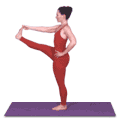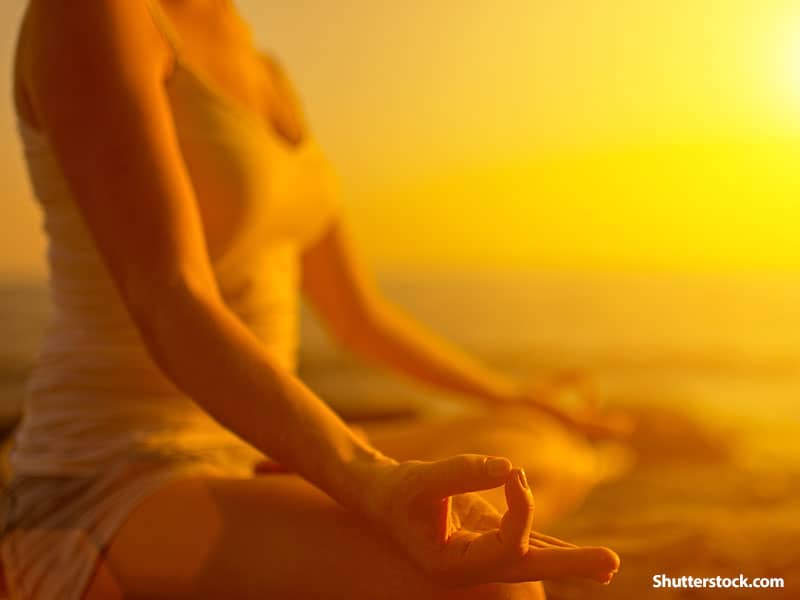--literally, "extended hand to the big toe pose"--is a great way for practitioners of all levels to explore "the perfection of imperfection." This deceptively straightforward posture requires a challenging combination of balance, strength, and flexibility. If you're a beginner, just getting into a rough approximation of the pose can be daunting. If you're a continuing student, you'll find that as soon as you've mastered one form of the pose, another more demanding variation awaits you.
To begin your practice, stand with your weight evenly balanced on both feet and the crown of your head floating toward the ceiling. (If you think your balance might be shaky, you may want to stand with your left shoulder a foot or so from a wall,

so you can reach out and steady yourself with your left hand if necessary.) [Figure 1] Take a moment to explore your balance in this simple standing pose. Is your weight evenly distributed between the right and left foot? Between the ball of the foot and the heel? Spread the toes and actively draw the kneecaps upward to firm the legs.
On an exhalation, keeping the spine long, bend the right knee toward your chest and hook the right big toe with the first two fingers of your right hand. Rest the left hand on your left hip and balance

on one leg for five to 10 long breaths. [Figure 2] Going this far might be challenge enough! Rest your eyes softly but steadily on a single point to help establish and maintain your balance.
If you want to go further, slowly begin to straighten the right leg, keeping hold of the big toe with your fingers. [Figure 3]

Let the pose unfold from your core, unfurling your leg like a flower blossoming out of your belly. Keep the left leg strong and straight. Resist the impulse to hunch forward over the lifted leg. Instead, keep the spine reaching toward the sky. Continue to drop the right hip down so the hips remain square and level with each other.
Stay in this pose for five more breaths. Let your brain relax. Tensing your muscles, holding your breath, and tightening your jaw and belly will only make things more difficult.
Now, if you're especially flexible, you can clasp the sides of the right foot with both hands and begin to draw your raised leg toward your chest, pressing out through the heel to keep the knee straight. Remember to keep sending energy through the left leg, keeping it straight and strong as well. Eventually, a very flexible yogi will be able to draw the raised leg all the way in to touch the forehead, while keeping the spine long and both legs straight.
When you've finished on one side, repeat the whole process with your other leg raised.
As you practice this pose, take the opportunity to cultivate a kind of spaciousness with yourself. Rather than constantly striving for the next, more "advanced," variation, take some time to check in and appreciate the pose at each step of the way. Let yourself feel the sensations coursing through your legs, belly, and spine. Notice how your practice changes from day to day. Your ability to balance, for instance, will be strongly affected by such daily factors as your stress level, the time of day, your menstrual cycle, your mood, and what you ate for dinner the night before. Such fluctuations are a natural part of a yoga practice.
Notice how you respond to your own limitations. Do you get angry, frustrated, and impatient? Do you find yourself blaming yourself, the pose, or the instructions? Now notice any tendency to judge yourself for your responses.
Remind yourself of one simple point: You will never be "done" with this posture. There will always be ways to take it deeper, to refine your alignment. There will always be people who can do it "better." Set aside these written instructions, this picture of the "ideal" finished pose. These are just freeze frames of a living, pulsing flow. They bear no
more resemblance to your actual experience than a cross-section of tissue preserved in formaldehyde on a scientist's microscope bears to a living, breathing animal.
Let yourself soften into a gentle, compassionate awareness of the pose you're actually in. See if you can love your tight hamstrings, your wobbly center of gravity, the hip that won't yield. Celebrate the marvel of being a body in motion. Let the pose emerge as an outward expression of your inner spirit--and know that whatever you're doing, you're
"doing it right."

